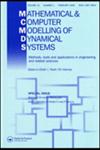孔隙弹性网络模型的Port Hamilton公式
IF 1.8
4区 数学
Q3 COMPUTER SCIENCE, INTERDISCIPLINARY APPLICATIONS
Mathematical and Computer Modelling of Dynamical Systems
Pub Date : 2020-12-03
DOI:10.1080/13873954.2021.1975137
引用次数: 20
摘要
摘要:我们研究了双场孔隙弹性模型和相关的多网络模型在地球科学或医学应用中的基于能量的公式。我们提出了系统方程的端口哈密顿公式,这有利于在离散化或模型降阶后保持重要的系统性质。为此,我们包括了通常省略的二阶项,并考虑了相应的一阶公式。然后通过(形式上)设置二阶项为零,获得准静态情况下的端口哈密顿公式。此外,我们将孔隙弹性方程解释为具有内能的子模型网络的互连,增加了对孔隙弹性方程的控制理论理解。本文章由计算机程序翻译,如有差异,请以英文原文为准。
Port-Hamiltonian formulations of poroelastic network models
ABSTRACT We investigate an energy-based formulation of the two-field poroelasticity model and the related multiple-network model as they appear in geosciences or medical applications. We propose a port-Hamiltonian formulation of the system equations, which is beneficial for preserving important system properties after discretization or model-order reduction. For this, we include the commonly omitted second-order term and consider the corresponding first-order formulation. The port-Hamiltonian formulation of the quasi-static case is then obtained by (formally) setting the second-order term zero. Further, we interpret the poroelastic equations as an interconnection of a network of submodels with internal energies, adding a control-theoretic understanding of the poroelastic equations.
求助全文
通过发布文献求助,成功后即可免费获取论文全文。
去求助
来源期刊
CiteScore
3.80
自引率
5.30%
发文量
7
审稿时长
>12 weeks
期刊介绍:
Mathematical and Computer Modelling of Dynamical Systems (MCMDS) publishes high quality international research that presents new ideas and approaches in the derivation, simplification, and validation of models and sub-models of relevance to complex (real-world) dynamical systems.
The journal brings together engineers and scientists working in different areas of application and/or theory where researchers can learn about recent developments across engineering, environmental systems, and biotechnology amongst other fields. As MCMDS covers a wide range of application areas, papers aim to be accessible to readers who are not necessarily experts in the specific area of application.
MCMDS welcomes original articles on a range of topics including:
-methods of modelling and simulation-
automation of modelling-
qualitative and modular modelling-
data-based and learning-based modelling-
uncertainties and the effects of modelling errors on system performance-
application of modelling to complex real-world systems.

 求助内容:
求助内容: 应助结果提醒方式:
应助结果提醒方式:


